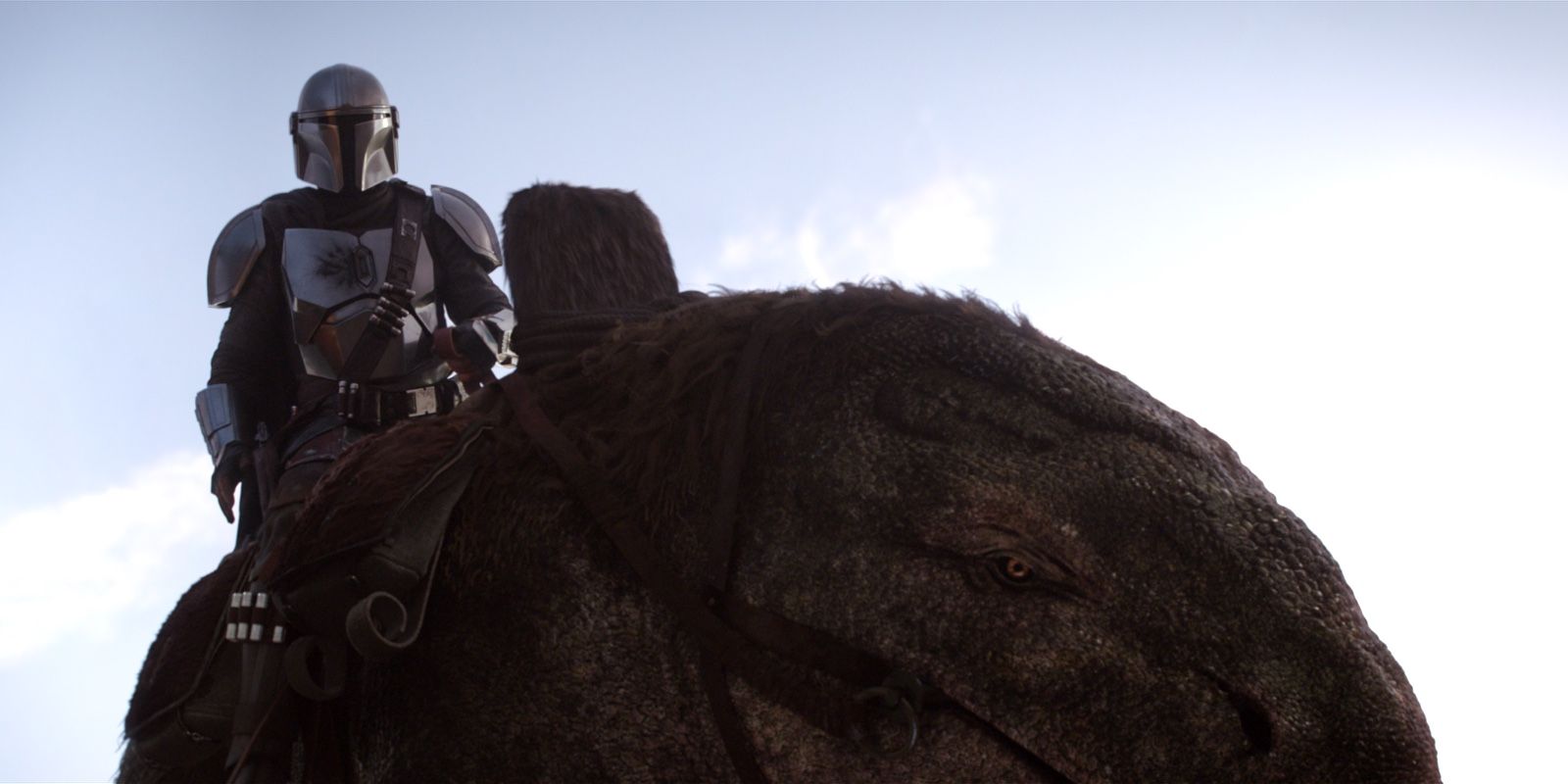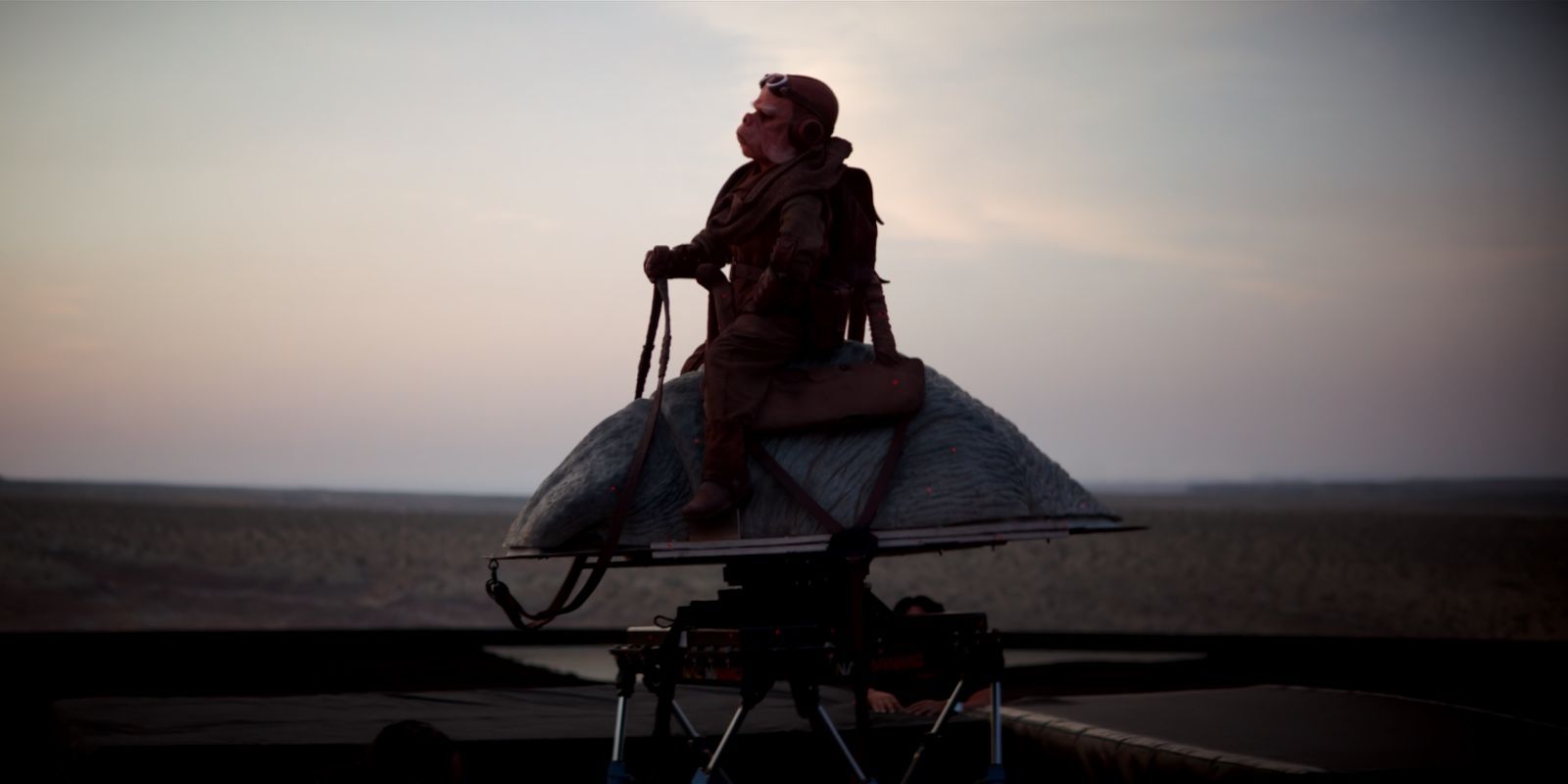Last year, Star Wars finally made the leap to live-action TV with The Mandalorian, Disney+'s flagship program. While Baby Yoda became an instant sensation and quick fan-favorite, the show also generated headlines for what it was doing behind the scenes. Ever since the original Star Wars film premiered in 1977, the franchise has been synonymous with innovative visual effects, and The Mandalorian was no different. Pixomondo was one of the visual effects studios to lend their talents to the show, with roughly 400 artists working to produce 500 shots. Among Pixomondo's many contributions to The Mandalorian was creature design, ranging from newcomers like the Blurrg to classics such as Dewbacks.
Just like the Star Wars films that came before it, The Mandalorian earned considerable praise for its groundbreaking visual effects, most notably with the Volume, which is poised to completely revolutionize the industry. Screen Rant was fortunate enough to talk with Pixomondo's Goran Backman about working on The Mandalorian and how the techniques pioneered will change things moving forward.
Star Wars is a franchise known for innovating visual effects. In your mind, how does The Mandalorian continue that tradition?
Goran Backman: With the Mandalorian, we have embarked on what I believe will be a bit of a revolution in our industry.
ILM teamed up with Epic games and created a new way to shoot content. We no longer must travel to specific locations to shoot, worry about the cost of recreating classical locations or whatever wrench the weather might throw in.
They developed what we called the Volume, which is a massive set of LED panels in a cylindrical shape surrounding a practical set. These LED panels displays real time CG imagery powered by Unreal Engine. The practical camera is tracked in real-time with the virtual camera, so when your practical camera is moving you also now see the background shifting perspective and parallaxing correctly. Now all you have to create practically is the area inside the volume and you’ll end up with a full environment. This is a set setup inside a limiting sound stage, but through the lens it looks like a vast landscape.
This adds a bunch of other benefits. You don't have to worry as much about lighting your subjects in a specific way to make them sit within an environment that you have yet to create, because all these LED panels are now lighting up the subjects with the correct brightness and color of the environment that we're in. Everything sits together as it should. The director can see the final shot and what it's actually going to look like live, and approve shots that would previously have to be a traditional post-production type of job.
So, it's going to change how we make movies and television, for sure. It's one of the largest leaps in our industry that I've experienced.
Do you think at some point we're going to get to a big Marvel-type tentpole movie being made in the Volume?
Goran Backman: I do, yeah. I think it's going to become common case quickly. Especially now with COVID as well; it's just really going to make this technology get pushed forward at a faster pace than it would have without it. It comes at the - it's hard to say 'perfect time' when it comes to something as tragic as a pandemic - but it does come at a good time for our industry. Even without this circumstance it will change how people tackle big VFX-heavy shots and shows.
What are some of the challenges in making The Mandalorian's visual effects on par with what viewers are used to in the Star Wars movies?
Goran Backman: That is a big challenge, because it is after all a TV show and people are used to features, as you say. The solution is being efficient with your work. You have to have a lot of good communication. Richard Bluff, ILM VFX supervisor, and their whole team always ensured we’d have a great starting point. They gave us plenty of concept drawings and anything that would be applicable or related to our shots and the assets that we were creating. We also took time to discuss the things that were important to them to tell the story so we knew what to focus on.
This really helped us out in trying to get something that's going to hold up on a TV budget. Star Wars has a high bar, for sure, but it's exciting tackle something like that and making sure it's as polished as it should be.
What was it like recreating some of the classic Star Wars locations like Tatooine and Mos Eisley?
Goran Backman: Yeah, I'm a longtime Star Wars fan since - my entire life, really. It was an honor to work with these people, and a humbling experience to work with people that had a hand in all these things that I grew up with and have come to love. It was a great opportunity for me.
What are some of the biggest differences between doing visual effects for a TV series compared to a movie?
Goran Backman: It goes back to time and making sure you're being as efficient as possible. You have to be careful when you plan shots, making sure you use all the different departments you have at your disposal to their biggest potential and that you tackle the tasks at hand in the most efficient way. We had about 400 artists working in a lot of different departments doing both 2D and 3D work, so the launch point for each task becomes crucial to managing this workload.
Which Mandalorian sequence was the most challenging to complete?
Goran Backman: The most challenging must have been some of the work that we did on episode 1, which involves a creature called the Blurrg. This was our first creature that we built for the show and we were also responsible for the shots where the Blurrg is featured. We had to tackle the challenge of placing actors on top of a CG creature and making sure all the weight and interaction between the two worked and got sold as the seamless illusion that it should be. We had to take extra care when it came to the details of the Blurrg. Sometimes we got really close to its face and its eyes, so we needed to ensure that all the little pieces – like the small odd hair strands or little teardrops from the corner of its eye, even down to the fibers of the iris – were created correctly. The eye was something Richard and Jon Favreau was keen to see really come alive.
We started early on the show for this reason, to make sure these demanding shots got the required attention. One of our initial challenges was figuring out how to drive the practical buck. The buck is what we call the seat actors would ride, it’s essentially a rodeo bull that has a small top back section of a practical Blurrg with a saddle on top. This is driven by a motion base, which is a mechanical device with pistons that drive this flat surface, where the buck sits on top of. Now you have something that allows one to move actors around on to get the correct weight and motion performance.
To get our animation to drive the buck we developed a system where we could see this motion base with the pistons in our animation software, Maya. We would attach a CG motion base in 3D, that was built to match the dimensions of to its real-world counterpart, to our creature inside Maya. So, when we moved our creature you could also see those pistons move in 3D space. The pistons would stretch and compress as far as they could, and a red indicator on the pistons would tell us when they’d go out of range. If we for instance moved the Blurrg too far out to this range, some of the pistons would not be able to reach and turn red. This way, we knew exactly how far we could push the animation; when we were safe and when we were not.
The next step was to give this animation to people on set. They would take our animation data and apply that to the practical motion base and drive it exactly the way we animated it. We gave them generic walk cycles, run cycles and idle animations to use as well as shot-specific animations. We had laid out what would happen in the sequences shot by shot before shooting to give the on-set crew the best starting point as possible.
After shooting ILM would then tell us what parts of our animations they used for what shot. We’d then cut up our animations accordingly into the shots given back to us, replace the buck with our CG Blurrg, and watch as things would just line up.
Having that kind of link between our post-production work and the practical side really helped us out in making sure that everything felt real. The actors’ legs would not crash into the creature's body, their inertia from the Blurrg moving around would be correct, and there would be no guessing game in figuring out how far to push things.
It was an involved process, but it worked out well. If you do not do it in a way like this, and shoot footage that might not be what’s required, you could end up having to push the footage around and essentially forcing an action after the fact. It can sometimes feel a little bit like the weight is off, or you’ll have to go with a more costly approach and replace the actor with a CG actor. It was an interesting way to deal with this problem, and it worked out great in the end.
Since we're talking about The Mandalorian, I have to ask if you did any work with Baby Yoda.
Goran Backman: I get that question a lot, but no, we largely did not. Baby Yoda was practical for the vast majority of the shots. Favreau grew up with Star Wars and has a love for the way they did the old movies: the creatures were practical and stop-motion animated. So he was wanting to use practical as much as he could, and Baby Yoda is a nice example of that still, to this day, being a viable option. There is a lot of charm you get from using puppets.
There are a few instances where ILM used a CG Yoda Baby, where they just couldn't get the puppet to perform the way a shot asked for. We helped out with some paint out for wires and other parts that drove the puppet, but that was the extent of it. If we would have a shot that required a CG Baby Yoda we would do everything but that and send the shot back to ILM, and they would add Baby Yoda afterwards. But yeah, we all are big fans of Baby Yoda here at Pixomondo.


